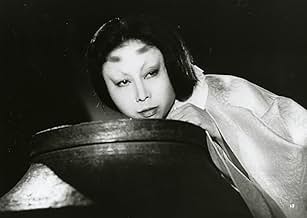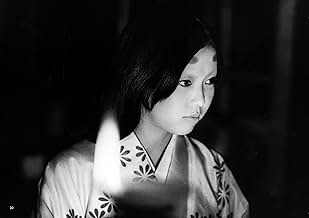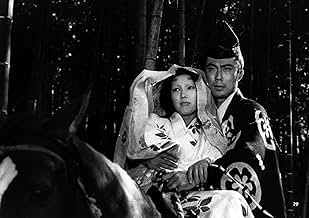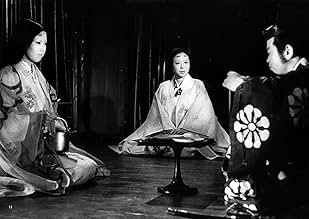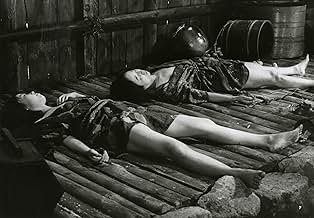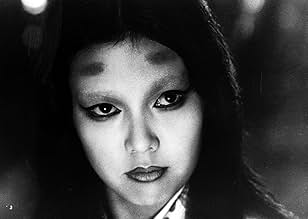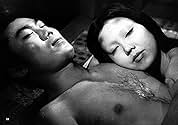VALUTAZIONE IMDb
7,7/10
9057
LA TUA VALUTAZIONE
Due donne vengono violentate e uccise dai soldati samurai. Presto riappaiono come fantasmi vendicativi che seducono e uccidono brutalmente il samurai di passaggio.Due donne vengono violentate e uccise dai soldati samurai. Presto riappaiono come fantasmi vendicativi che seducono e uccidono brutalmente il samurai di passaggio.Due donne vengono violentate e uccise dai soldati samurai. Presto riappaiono come fantasmi vendicativi che seducono e uccidono brutalmente il samurai di passaggio.
- Regia
- Sceneggiatura
- Star
- Premi
- 2 vittorie totali
Trama
Lo sapevi?
- QuizKuroneko (1968) was placed in competition at the 1968 Cannes Film Festival, but the festival was canceled due to the events of May 1968 in France.
- BlooperWhen the cat crawls over the bodies after the fire, the mother can be seen to breathe.
- ConnessioniFeatured in Ebert Presents: At the Movies: Episodio #2.15 (2011)
Recensione in evidenza
Although somewhat similar in both tone and presentation to director Kaneto Shindō's earlier masterpiece Onibaba (1964), Kuroneko (1968) - which translates roughly as "the black cat" - adds a more theatrical, expressionistic element to the overall design of the film, which here works towards reinforcing the more obvious spiritual/supernatural elements of the story and that unforgettable sense of nocturnal, dreamlike abstraction. As is often the case with Japanese supernatural horror stories, the plot of the film is an incredibly simple and moralistic one, dealing primarily with the notions of revenge and retribution re-cast as a pointed supernatural metaphor, with much emphasis placed on the overriding ideas of coincidence, karma and fate. In keeping with these particular ideas, Shindō creates a slow and atmospheric work that takes full advantage of the stark, unearthly ambiance suggested by the high-contrast black and white cinematography, which really helps to further underline the creation of this barren, war-torn period setting, filled with danger and despair.
Unlike Shindō's two most famous films of this period, the aforementioned Onibaba and his earlier classic The Naked Island (1960), Kuroneko sees the director moving even further away from his earlier interest in naturalistic environments - and the use of those unforgettable landscapes to underline the unspoken elements of the drama - and instead illustrates an interest in studio-based production, in a clear attempt to capture the sense of desolate, otherworldliness presented by the claustrophobic netherworld that the spirits of the film inhabit. By mixing these two styles together - cutting from a location to a studio to illustrate the characters moving between the two different worlds of the film - Shindō is able to create a further degree of heightened atmosphere, tension and theatrical abstraction that is further illustrated by the expressive use of costumes and kabuki-like make-up effects, combined with the director's continuing experiments with sound design and atonal musical composition.
The harsh tone of the film is established right from the very beginning, with the opening scene still standing as one of the most shocking and memorable of 1960's cinema, as Shindō takes us right back to the unforgettable images of Onibaba and a scene of deplorable brutality that will reverberate throughout the rest of the film. Here, we fade in on a shot of a small hut surrounded by long billowing grass and tall, leafy trees in the heart of rural Kyoto. Shindō holds the shot for an incredibly long time, establishing the incredibly slow and deliberate pace that the rest of the film will employ, before we finally see an armed warrior emerging from the bushes. His movements are slow and furtive, as he stealthily moves closer to the hut looking for food and supplies. Eventually, more soldiers appear, phantom-like from foliage and move closer towards the hut. Sleeping inside are an old woman and her daughter in law. The soldiers descend on the hut, much to the shock and surprise of the two women who try desperately to force the intruders away; however, eventually realising that the supply rations of the hut are meagre and unsatisfactory the soldiers gang-rape the two women, and burn their hut to the ground.
Here, Shindō films a violent scene that could have easily become lurid and exploitative with a pervasive sensitivity; establishing the brutality to come before cutting to an exterior shot that he once again holds for a number of minutes, creating a tragic subversion of the previously tranquil setting that opened the film. As the smoke begins to pour from the hut and the soldiers, once again, ghost-like and oppressive, filter back into the tree line we know that the film has crossed a threshold into darker territory from which it simply cannot return. With the thematic elements of this tragic, dramatic set up - combined with the period in which the film is set and the approach of the director - you can certainly see positive similarities to Ingmar Bergman's punishing rape/revenge drama The Virgin Spring (1960). However, whereas Bergman used this aspect of the plot to riff on spirituality and a suffocating, existentialist riddle; Shindō is instead more interested in mining a path of slow-building terror and blood-thirsty retribution.
To reveal any more would spoil the impact of the film and the odd, erotic atmosphere that Shindō skilfully creates through the combination of stylised photography, choreography, production design, lighting, music and editing. It is at times reminiscent of Mario Bava's excellent Gothic horror films The Mask of Satan (1960) and Kill, Baby... Kill (1966) in regards to the evocative stylisations and emphasis on mood and design; though also bringing to mind the brilliance of Masaki Kobayashi's masterpiece Kwaidan (1964), in particular the segment entitled "The Woman of the Snow". If you're already familiar with Onibaba (one of the greatest films ever made), then you'll have some idea of what to expect from the direction of Kuroneko, with the incredibly atmospheric use of black and white cinematography - making full use of that expansive, Cinemascope frame - augmented by an intelligent approach to production and location design and the slow, evocative atmosphere of nocturnal nightmare and fever dream obsession created by the story itself.
Unlike Shindō's two most famous films of this period, the aforementioned Onibaba and his earlier classic The Naked Island (1960), Kuroneko sees the director moving even further away from his earlier interest in naturalistic environments - and the use of those unforgettable landscapes to underline the unspoken elements of the drama - and instead illustrates an interest in studio-based production, in a clear attempt to capture the sense of desolate, otherworldliness presented by the claustrophobic netherworld that the spirits of the film inhabit. By mixing these two styles together - cutting from a location to a studio to illustrate the characters moving between the two different worlds of the film - Shindō is able to create a further degree of heightened atmosphere, tension and theatrical abstraction that is further illustrated by the expressive use of costumes and kabuki-like make-up effects, combined with the director's continuing experiments with sound design and atonal musical composition.
The harsh tone of the film is established right from the very beginning, with the opening scene still standing as one of the most shocking and memorable of 1960's cinema, as Shindō takes us right back to the unforgettable images of Onibaba and a scene of deplorable brutality that will reverberate throughout the rest of the film. Here, we fade in on a shot of a small hut surrounded by long billowing grass and tall, leafy trees in the heart of rural Kyoto. Shindō holds the shot for an incredibly long time, establishing the incredibly slow and deliberate pace that the rest of the film will employ, before we finally see an armed warrior emerging from the bushes. His movements are slow and furtive, as he stealthily moves closer to the hut looking for food and supplies. Eventually, more soldiers appear, phantom-like from foliage and move closer towards the hut. Sleeping inside are an old woman and her daughter in law. The soldiers descend on the hut, much to the shock and surprise of the two women who try desperately to force the intruders away; however, eventually realising that the supply rations of the hut are meagre and unsatisfactory the soldiers gang-rape the two women, and burn their hut to the ground.
Here, Shindō films a violent scene that could have easily become lurid and exploitative with a pervasive sensitivity; establishing the brutality to come before cutting to an exterior shot that he once again holds for a number of minutes, creating a tragic subversion of the previously tranquil setting that opened the film. As the smoke begins to pour from the hut and the soldiers, once again, ghost-like and oppressive, filter back into the tree line we know that the film has crossed a threshold into darker territory from which it simply cannot return. With the thematic elements of this tragic, dramatic set up - combined with the period in which the film is set and the approach of the director - you can certainly see positive similarities to Ingmar Bergman's punishing rape/revenge drama The Virgin Spring (1960). However, whereas Bergman used this aspect of the plot to riff on spirituality and a suffocating, existentialist riddle; Shindō is instead more interested in mining a path of slow-building terror and blood-thirsty retribution.
To reveal any more would spoil the impact of the film and the odd, erotic atmosphere that Shindō skilfully creates through the combination of stylised photography, choreography, production design, lighting, music and editing. It is at times reminiscent of Mario Bava's excellent Gothic horror films The Mask of Satan (1960) and Kill, Baby... Kill (1966) in regards to the evocative stylisations and emphasis on mood and design; though also bringing to mind the brilliance of Masaki Kobayashi's masterpiece Kwaidan (1964), in particular the segment entitled "The Woman of the Snow". If you're already familiar with Onibaba (one of the greatest films ever made), then you'll have some idea of what to expect from the direction of Kuroneko, with the incredibly atmospheric use of black and white cinematography - making full use of that expansive, Cinemascope frame - augmented by an intelligent approach to production and location design and the slow, evocative atmosphere of nocturnal nightmare and fever dream obsession created by the story itself.
- ThreeSadTigers
- 5 lug 2008
- Permalink
I più visti
Accedi per valutare e creare un elenco di titoli salvati per ottenere consigli personalizzati
- How long is Black Cat?Powered by Alexa
Dettagli
- Tempo di esecuzione1 ora 39 minuti
- Colore
- Proporzioni
- 2.35 : 1
Contribuisci a questa pagina
Suggerisci una modifica o aggiungi i contenuti mancanti



